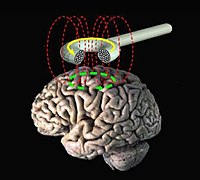
Photo from wikipedia
The purpose of the study was twofold: (1) determine if different time delays (30 min or 6 h) between training and a post-training test with a rhythmic bimanual pattern (90° relative phase)… Click to show full abstract
The purpose of the study was twofold: (1) determine if different time delays (30 min or 6 h) between training and a post-training test with a rhythmic bimanual pattern (90° relative phase) would be associated with different levels of consolidation for the motor and spatial representations of the pattern; and (2) determine if training with the rhythmic bimanual pattern would lead to enhanced corticospinal excitability in M1 linked to changes in motor and spatial performance measures. Coordination accuracy and stability of the 90° pattern improved over practice. Coordination accuracy and stability were the same after a 30-min or 6-h delay between training and the post-training test, indicating equivalent levels of consolidation in the motor representation. The 6-h delay interval resulted in shorter visual recognition times compared to the 30-min delay and was centered on the trained 90° pattern. These findings indicate the consolidation of the spatial representation was more time sensitive compared to the motor representation in the current task. Motor evoked potentials (MEPs) from the first dorsal interosseous muscle (FDI) generated by single-pulse transcranial magnetic stimulation (TMS) were measured at baseline (before training) and at 6-min and 21-min intervals post-training with the 90° pattern. Increased corticospinal excitability in M1 was evidenced by larger MEPs of the FDI muscle at the 6-min interval. This increased excitability after training is a novel finding after training with a difficult and initially unstable rhythmic bimanual pattern. No significant correlations were found between the MEP data and behavioral data; thus, the increased excitability in M1 may have been linked to the difficulty in performing the pattern, consolidation processes, or both.
Journal Title: Experimental Brain Research
Year Published: 2020
Link to full text (if available)
Share on Social Media: Sign Up to like & get
recommendations!